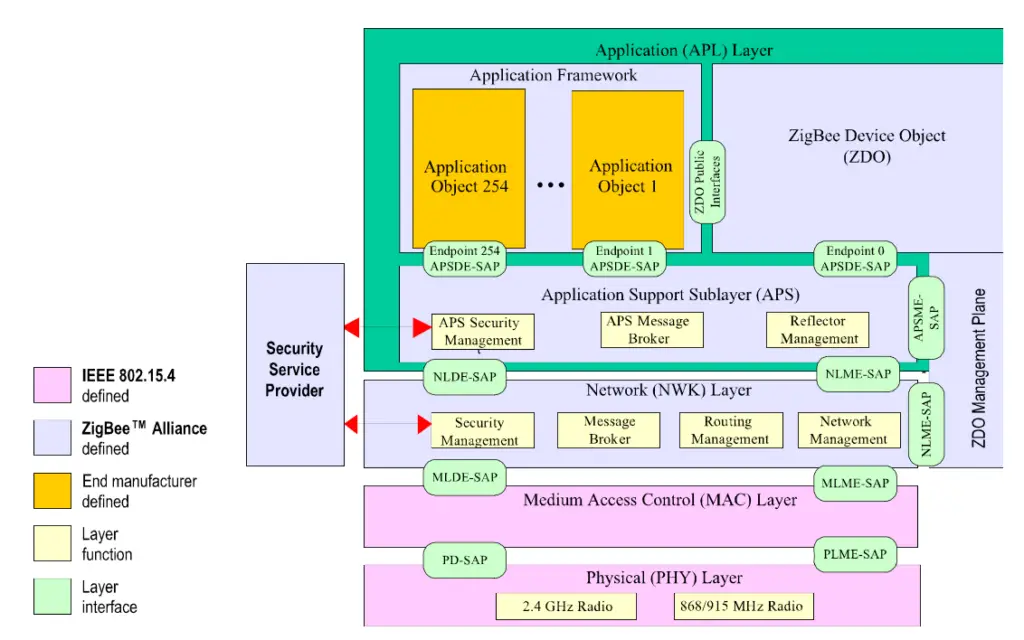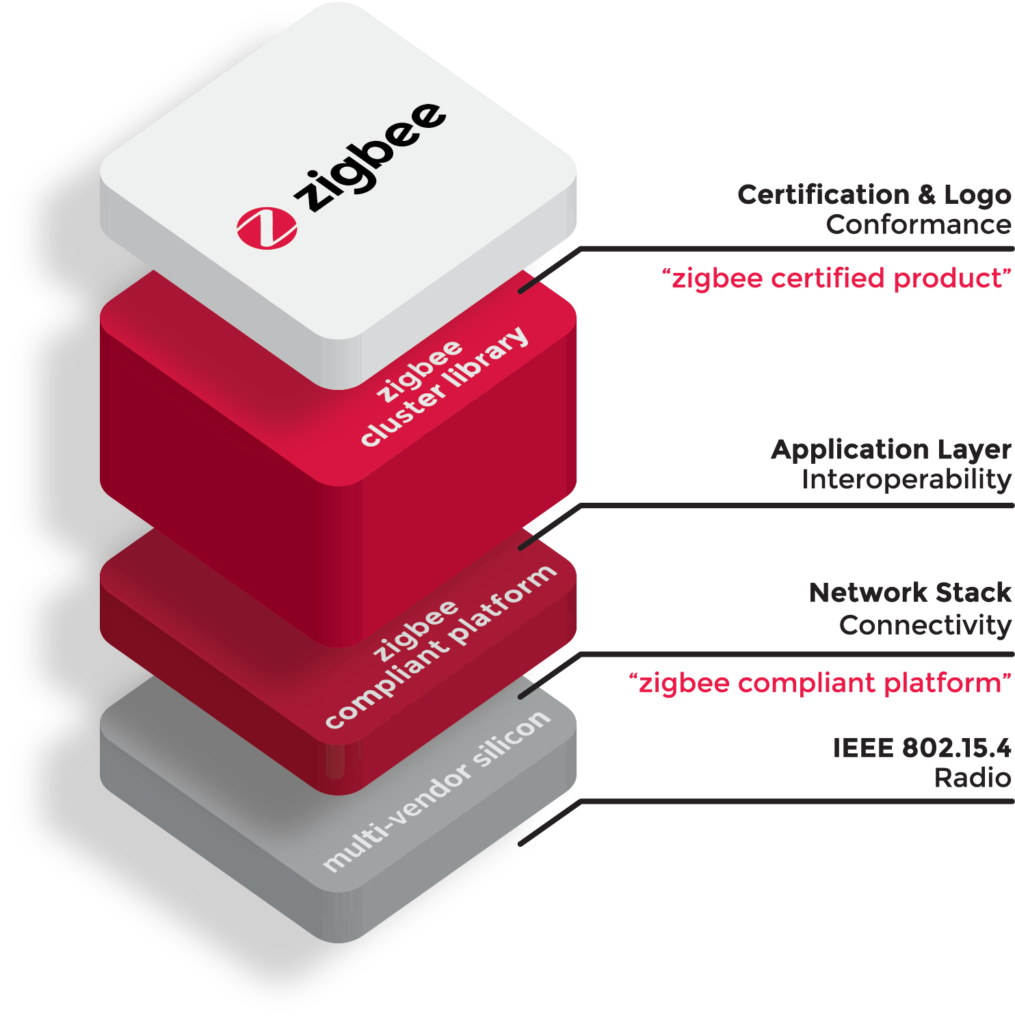Looking to understand the Zigbee protocol stack? Learn how this wireless communication standard operates with our comprehensive guide. Explore the layers of the Zigbee protocol stack, including the physical, network, and application layers.
Table of Contents
ZigBee is a wireless communication protocol designed for low-power, low-data-rate applications. It is commonly used in home automation, smart lighting, and other Internet of Things (IoT) applications.

The ZigBee protocol defines a stack of layers that work together to provide reliable communication between devices.
Zigbee Protocol Stack
The ZigBee stack consists of the following layers:
Application Layer
This is the topmost layer in the ZigBee stack. It defines the application-specific functionality and data structures that are exchanged between devices.
It is responsible for handling device-specific operations such as sensor readings, device status updates, and control commands.
ZigBee Device Object (ZDO) Layer
This layer provides the interface between the application layer and the rest of the ZigBee stack. It handles device discovery, management, and network formation.
ZigBee Network Layer (ZNL)
This layer provides the functionality to create and manage a ZigBee network.
It handles the routing of messages between devices in the network and supports both mesh and star network topologies.
ZigBee MAC Layer
This layer provides the interface between the network layer and the physical layer. It handles the transmission and reception of data and provides services such as security, acknowledgment, and error detection.
ZigBee Physical Layer (PHY)
This is the lowest layer in the ZigBee stack. It is responsible for transmitting and receiving data over the wireless channel. It handles tasks such as frequency selection, modulation, and signal encoding.
The ZigBee stack is designed to be modular and flexible, allowing developers to choose the layers and features that best suit their application requirements. This makes it an ideal protocol for low-power IoT devices that require reliable, low-data-rate communication.
ZigBee Physical Layer (PHY)
The ZigBee PHY supports operation in the 2.4 GHz, 915 MHz, and 868 MHz frequency bands, depending on the region in which the network is deployed.
- Data rates: The ZigBee PHY supports multiple data rates, ranging from 20 kbps to 250 kbps. The choice of data rate depends on the application requirements, with lower data rates typically used for low-power, low-bandwidth applications and higher data rates used for applications that require more bandwidth.
- Modulation schemes: The ZigBee PHY supports two modulation schemes: Offset Quadrature Phase Shift Keying (O-QPSK) and Binary Phase Shift Keying (BPSK). O-QPSK is used for higher data rates, while BPSK is used for lower data rates.
- Channel access: The ZigBee PHY uses a Time Division Multiple Access (TDMA) scheme for channel access. This allows multiple devices to share the same channel without interfering with each other.
- Power consumption: The ZigBee PHY is designed for low-power operation, with features such as power amplification control and low-power sleep modes that help to conserve battery life.
In general, the ZigBee Physical Layer (PHY) is responsible for transmitting and receiving data over the wireless channel. It supports multiple frequency bands, data rates, and modulation schemes, and is designed for low-power operation.
The ZigBee PHY is a key component of the ZigBee protocol stack, enabling reliable wireless communication for a wide range of IoT applications.
ZigBee MAC Layer
ZigBee Media Access Control (MAC) layer is the layer in the ZigBee protocol stack that is responsible for controlling access to the wireless medium. The ZigBee MAC layer defines how devices share the wireless channel, how they synchronize with each other, and how they exchange data.
Here are some of the key features of the ZigBee MAC layer:
- Carrier Sense Multiple Access with Collision Avoidance (CSMA/CA): The ZigBee MAC layer uses a CSMA/CA scheme to control access to the wireless medium. Before transmitting, a device listens to the channel to make sure it is clear. If the channel is busy, the device waits for a random period of time before trying again. This helps to avoid collisions between devices trying to transmit at the same time.
- Beacon-enabled network: In a beacon-enabled network, the ZigBee coordinator periodically broadcasts a beacon that contains information about the network, such as the network ID, channel number, and superframe structure. Devices in the network can synchronize their transmissions to the beacon, which helps to improve energy efficiency and reduce collisions.
- Superframe structure: The ZigBee MAC layer divides the network into superframes, which are further divided into active and inactive periods. During the active period, devices can transmit data using either Guaranteed Time Slots (GTS) or contention-based access. GTS are reserved time slots that are allocated by the coordinator to specific devices for guaranteed access. Contention-based access allows devices to transmit data if they win a contention process, similar to the CSMA/CA scheme.
- Acknowledgments: The ZigBee MAC layer uses acknowledgments (ACKs) to confirm successful data transmissions. Devices send ACKs to the sender after receiving data packets to indicate that the packet was received correctly.
- Security: The ZigBee MAC layer provides several security mechanisms, including encryption, message authentication, and device authentication. These mechanisms help to ensure that only authorized devices can join the network and communicate with each other.
The ZigBee MAC layer is responsible for controlling access to the wireless medium and ensuring reliable transmission of data. It uses a CSMA/CA scheme for channel access, a beacon-enabled network for synchronization, a superframe structure for efficient use of the channel, and acknowledgments for confirming successful data transmissions.
The ZigBee MAC layer also provides several security mechanisms to ensure the integrity and confidentiality of the network.
ZigBee Network Layer (ZNL)
The ZigBee Network Layer (ZNL) is the layer in the ZigBee protocol stack that is responsible for managing the network topology and routing messages between devices. The ZNL is implemented by the network layer of the ZigBee stack and provides several key features that enable efficient communication between devices.
Here are some of the key features of the ZigBee Network Layer:
- Device discovery and joining: The ZigBee network layer provides mechanisms for devices to discover and join the network. Devices can either join as end devices or routers, depending on their capabilities.
- Network topology: The ZigBee layer defines the network topology, which can be either star or mesh. In a star topology, all devices communicate directly with the coordinator. In a mesh topology, devices can communicate directly with each other, which allows for more efficient routing of messages.
- Addressing: The ZigBee network layer provides a hierarchical addressing scheme that allows devices to be addressed by their 16-bit short address or their 64-bit IEEE address. The addressing scheme also includes a network address, which identifies the network that the device belongs to.
- Routing: The ZigBee network layer provides several routing options, including unicast, multicast, and broadcast. Unicast messages are sent to a specific device, multicast messages are sent to a group of devices, and broadcast messages are sent to all devices in the network.
- Routing tables: The ZigBee network layer maintains routing tables that are used to route messages between devices. The routing tables include information about the devices in the network and the paths between them.
- Security: The ZigBee network layer provides several security mechanisms, including encryption, message authentication, and device authentication. These mechanisms help to ensure that only authorized devices can join the network and communicate with each other.
In summary, the ZigBee Network Layer (ZNL) manages the network topology and routing messages between devices.
It provides mechanisms for device discovery and joining, a hierarchical addressing scheme, routing options including unicast, multicast, and broadcast, routing tables, and security mechanisms to ensure the integrity and confidentiality of the network.
ZigBee Device Object (ZDO)
The ZigBee Device Object (ZDO) layer is an important layer in the ZigBee protocol stack. It is responsible for providing the interface between the application layer and the rest of the ZigBee stack.
The ZDO layer provides functions for device discovery, management, and network formation.
Key functions provided by the ZDO layer:
Network discovery
The ZDO layer is responsible for discovering other ZigBee devices in the network. This is done by sending out discovery requests and listening for responses from other devices.
Network management
The ZDO layer handles the management of the network, including joining and leaving the network, and managing the network topology.
Endpoint management
The ZDO layer is responsible for managing the endpoints of a ZigBee device. Each endpoint is a logical entity that can provide specific functionality, such as a temperature sensor or a light switch.
Binding Management
The ZDO layer is responsible for managing the bindings between devices in the network. Bindings allow devices to communicate directly with each other, rather than going through intermediate nodes.
Security management
The ZDO layer provides functions for managing the security of the ZigBee network. This includes authentication, encryption, and key management.
In summary, the ZigBee Device Object (ZDO) layer is a crucial layer in the ZigBee protocol stack. It provides the interface between the application layer and the rest of the ZigBee stack and handles important functions such as device discovery, management, and network formation.
ZigBee Specification
IEEE 802.15.4 and ZigBee working model. The IEEE 802.15.4 standard specifies the physical (PHY) and Media Access Control (MAC) layers at the 868 MHz, 915 MHz, and 2.4 GHz ISM bands.
- Zigbee Protocol Stack Architecture
- Zigbee Application Layer
- Zigbee Network Layer
- Zigbee Physical Layer
- Zigbee Security
- Zigbee Profile
- Zigbee Software Development
- Zigbee Data Rate
- Zigbee End Devices
- Zigbee Mesh Networking

Securing Your Zigbee Network: A Comprehensive Guide to Managing Security Keys




![[Top] Zigbee Protocol Analyzer: What you need to know](https://www.offensive-wireless.com/wp-content/uploads/2022/04/Zigbee-Protocol-Analyzer-300x158.jpg)